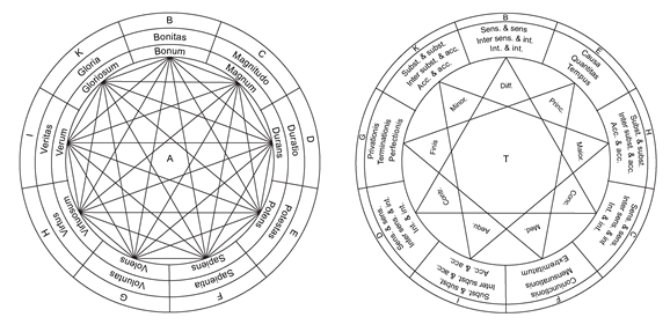1.
Introduction ^
2.
Poly ^
3.
The Method of Raimundus Lullus ^
4.
Discussion ^
5.
Conclusion and Outlook ^
6.
Acknowledgement ^
The author would like to thank Prof. Friedrich Lachmayer for initially pointing him to the work of Raimundus Lullus and in particular the Ars brevis.
7.
References ^
Bonner, A., What Was Llull Up To?, In: Fidora, A. and Sierra, C. (Eds.), Ramon Llull: From the Ars Magna to Artificial Intelligence, Artificial Intelligence Research Institute, IIIA, Barcelona, P. 5-24 (2011).
Brunschwig, C. R., Multisensory Law and Legal Informatics - A Comparison of How these Legal Disciplines Relate to Visual Law. In: Geist, A., Brunschwig, C.R., Lachmayer, F. & Schefbeck, G (Eds.), Strukturierung der Juristischen Semantik – Structuring Legal Semantics, Festschrift für Erich Schweighofer, Editions Weblaw, Bern, p. 573-668 (2011).
Fidora, A., Raimundus Lullus: Ars brevis (Latin-German Translation), Felix Meiner Verlag, Hamburg (1999).
Fidora, A. and Sierra, C. (Eds.), Ramon Llull: From the Ars Magna to Artificial Intelligence, Artificial Intelligence Research Institute, IIIA, Barcelona, (2011).
Fill, H.-G., Semantic Interpretations of Legal Visualizations using a Polysyntactic View, In: Geist, A., Brunschwig, C.R., Lachmayer, F. and Schefbeck, G. (Eds.), Strukturierung der Juristischen Semantik – Structuring Legal Semantics, Festschrift für Erich Schweighofer, Editions Weblaw, Bern p. 245-256 (2011).
Heer, F., Leibniz – Auswahl, Deutsche Buch-Gemeinschaft, Berlin - Darmstadt – Wien (1959).
Kahlig, W., Visualisierungstypologie des Deutschen Privatrechts. In: Jusletter IT 24. Februar 2011, (2011).
Karagiannis, D., Kühn, H., Metamodelling Platforms, Proceedings of the 3rd International Conference EC-Web 2002 - Dexa 2002 (2002), Full version: http://www.dke.at/fileadmin/DKEHP/publikationen/metamodell/FullVersion_MMP _DexaECWeb2002.pdf retrieved 10-01-2013.
Künzel, W., Cornelius, H., Die Ars generalis ultima des Raymundus Lullus: Studien zu einem geheimen Ursprung der Computertheorie, Künzel, Berlin (1991).
Leibniz, G., Dissertatio de Arte Combinatoria (1666), In: Gerhardt, C.I. (Ed.), Leibnizens gesammelte Werke, Publisher: H.W. Schmidt (1858), http://www.google.at/books?id=FSM1AAAAIAAJ&hl=de retrieved 10-01-2013.
De Lizarazo, S., Hieronymo, P., Generalis et admirabilis methodus ad omnes scientias facilius (...) addiscendas, in qua (...) Raimundi Lullii ars brevis explicatur (etc.), Turiasonae: Carolus a Lavayer, Reference in the Austrian National Library: http://data.onb.ac.at/rec/LZ01606419 accessed 31-08-2012, (1619).
Messer, B., Zur Interpretation formaler Geschäftsprozeß- und Workflow-Modelle, In: Becker, J., König, W., Schütte, R., Wendt, O. and Zelewski, S. (Eds.), Wirtschaftsinformatik und Wissenschaftstheorie - Bestandaufnahme und Perspektiven, Gabler, Wiesbaden, P. 95-123 (1999).
Tarski, A., Der Wahrheitsbegriff in den formalisierten Sprachen, Studia Philosophica I, P. 261-405 (1936).
Hans-Georg Fill, Universitätsassistent, University of Vienna, Research Group Knowledge Engineering.
- 1 In the medieval books of Lullus’ work these discs are cut out of paper and attached with little strings to the pages so that they can be actually rotated in the book. For example, the copy in the Austrian National Library features this mechanism [De Lizarazo and Hieronymo (1619].







